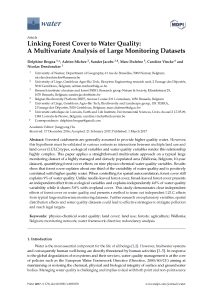Brogna D., Michez A., Jacobs S., Dufrêne M., Vincke C., Dendoncker N.
Abstract: Forested catchments are generally assumed to provide higher quality water. However, this hypothesis must be validated in various contexts as interactions between multiple land use and land cover (LULC) types, ecological variables and water quality variables render this relationship highly complex. This paper applies a straightforward multivariate approach on a typical large monitoring dataset of a highly managed and densely populated area (Wallonia, Belgium; 10-year dataset), quantifying forest cover effects on nine physico-chemical water quality variables. Results show that forest cover explains about one third of the variability of water quality and is positively correlated with higher quality water. When controlling for spatial autocorrelation, forest cover still explains 9% of water quality. Unlike needle-leaved forest cover, broad-leaved forest cover presents an independent effect from ecological variables and explains independently 4.8% of water quality variability while it shares 5.8% with cropland cover. This study demonstrates clear independent effects of forest cover on water quality, and presents a method to tease out independent LULC effects from typical large multivariate monitoring datasets. Further research on explanatory variables, spatial distribution effects and water quality datasets could lead to effective strategies to mitigate pollution and reach legal targets.
Consultez la notice complète de l’article sur ORBi

